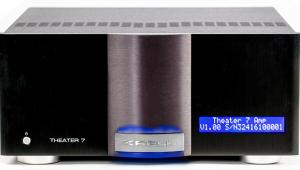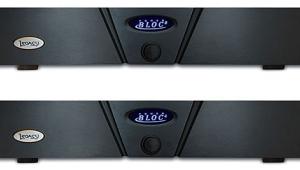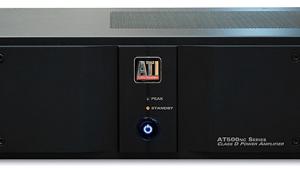Trinnov Amplitude16 16-Channel Power Amplifier Review Page 2
Setup
Over the years I've gotten quite good at swapping components in and out of my A/V rack and I always use the opportunity to do a good dusting and make sure the cables aren't in a tangled mess. For this review, I removed both of my ATI power amps and put the Amplitude 16 in the space previously occupied by the seven-channel amp. Strikingly, that amp outweighs the Trinnov by nearly 20 pounds even though it has fewer than half the channels.
To make the connection between the Altitude16 processor and Amplitude16 power amp, Trinnov sent me two eight-channel DB-25 cables (ACC-SUBD25-XLRF1.5M), which are 1.5 meters long and sell for $200 apiece. Hookup was a breeze, though I only needed to use 11 of the 16 available channels to power my setup, which includes three M&K S-150 speakers across the front, four M&K SS-150 surrounds, and four Atlantic Technology IC6-OBA height speakers in the ceiling.
This got me thinking about cost per channel. At $12,500, the Trinnov isn't cheap by any stretch but when you break it down, it works out to a respectable $781 per channel, which is in line with other high-end multichannel amplifiers. But since I'm only using 11 channels, cost per channel jumps 45% to $1,136, which hurts the value equation. Bridging channels does, however, provide a way to maximize the value equation. You could, for example, create three bridged channels to power the front, center, and left speakers and still have 10 channels left to power four surround speakers and six overheads in a Dolby Atmos or DTS:X setup.
Performance
I lived with the Amplitude 16 for a few days of casual listening before jumping into my full-scale evaluation. The first thing I noticed is this amp gets hot — really hot. Granted, we were having a 100+ degree heatwave in California during my evaluation, but my theater room never gets above 77 degrees. Anyway, after watching a few TV shows, I grabbed my IR thermometer and got a reading of 145 degrees at the vent that expels the heat. This is not the experience I've had with class-D amps in the past—they generally don't get above 110 degrees. Thinking that maybe my rack didn't have enough airflow (even though it's actively cooled with multiple PC fans), I pulled the Amplitude16 out of my rack and placed it out in the open with no obstructions. This helped a little with the temperature dropping to 140 degrees — still higher than I'm accustomed to.

I performed an audio calibration using Trinnov's Setup Wizard and settled in for some serious listening, starting with the opening sequence of Netflix's The Adam Project. While I generally find the audio on streaming services to be lacking, this Dolby Atmos soundtrack seems to be the exception. The film starts with Adam Reed (Ryan Reynolds) fleeing Earth in his spaceship to The Spencer Davis Group's "Gimme Some Lovin.'" The action-packed scene put every speaker in the room to work, including my four subwoofers. (In case you're wondering, the Altitude16's sub output feeds a Dirac miniDSP 2x4 HD processor that treats the subs as one, hence the system's 7.1.4 designation.) Though the Amplitude16 was running hot, its ICEpower modules handled the sequence with ease: the overhead speakers came alive as the spaceship zoomed through the screen. Reynolds' sarcastic dialogue was clear and fully intact and the backing music was appropriately powerful and dynamic.
Next up, The Batman on UHD Blu-ray. This latest incarnation of the caped crusader's adventures has one of the best overall Atmos soundtracks I've heard. The freeway chase scene (Chapter 9) with its discrete effects, wide dynamic range, and copious amounts of deep-digging bass sounded spectacular and proved that the Amplitude 16 was more than up to the task of powering my home theater. Rainfall was authentic and the crack of gunshots was crisp and real as the thunderous roar of the Batmobile enveloped the room. I've watched this scene nearly a dozen times and the Trinnov with its ICEpower modules did not disappoint, handling the mayhem as well as my reference ATI amplifiers.
Concert Blu-rays were every bit as impressive. John Williams Live in Vienna showcases the work of one of the most accomplished music composers of our time, and hearing the Vienna Philharmonic with world-class violinist Anne-Sophie Mutter playing iconic theme songs from Star Wars, Harry Potter, Jurassic Park, and Indiana Jones in Atmos was quite a treat. With my eyes closed, it was as if I had been transported to one of the finest concert halls in the world.
My "being there" experience continued with a broad sampling of FLAC music files as the amp drove my speakers to reference levels without ever sounding harsh or fatiguing. Female voices and string instruments, in particular, sounded natural and clean, leaving me with no reservations about the Amplitude16's ability to convey the power and nuance of music.
Conclusion
Traditionalists may scoff at class-D amplifier technology, but I've been a fan of the design for nearly 15 years and have found well-engineered class-D amplifiers to equal, and sometimes surpass, the performance of the best class-AB amplifiers on the market. Such is the case with the Amplitude16. Its unique 16-channel architecture is a tribute to Trinnov's engineering prowess but the trade-off is an abundance of heat that needs to be dissipated from a cramped enclosure. Still, the amp performed up to my high expectations and never once shut down or faltered during my listening tests. If you're in the market for up to 16 channels of amplification and are tight on rack space, the Amplitude16 power amplifier is a solid performer worthy of consideration.





























































